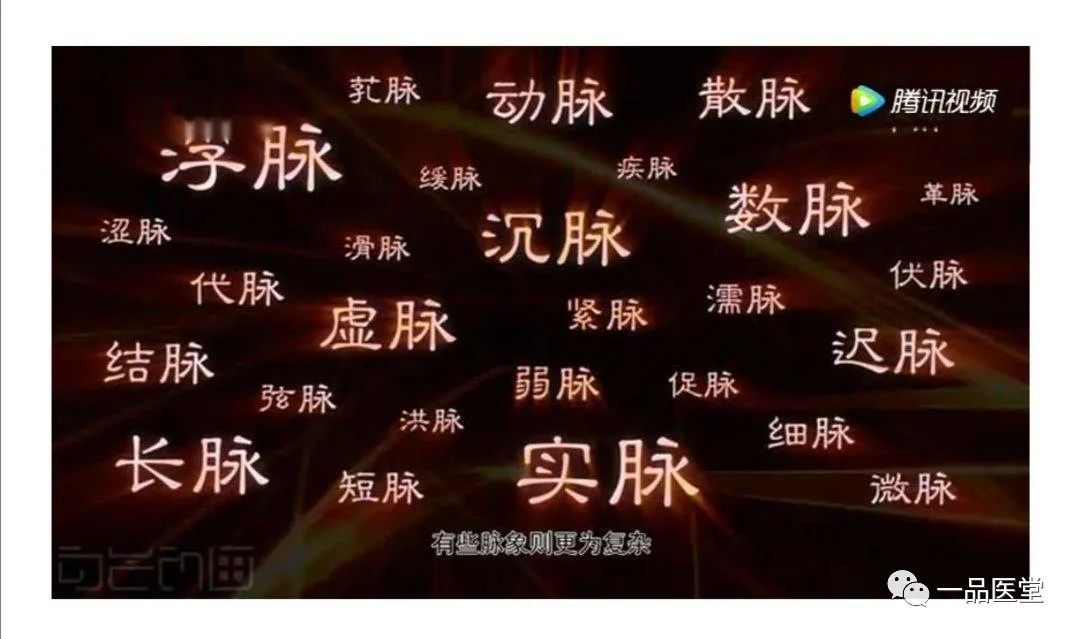
-
Floating Pulse (Fu Mai): When lightly pressed, the pulse feels strong; with slightly heavier pressure, it appears weak. It should be differentiated from:
Empty Pulse (Kao Mai) – floating and large, with a feeling of emptiness upon deeper pressure. Surging Pulse (Hong Mai) – floating and forceful. Weak Pulse (Xu Mai) – slow and slightly large, but empty and weak. Soft Pulse (Ruan Mai) – floating, soft, and fine. Scattered Pulse (San Mai) – floating without a root, coming and going indistinctly, like scattered willow fluff.
2. Deep Pulse (Chen Mai): Requires significant pressure to reach the pulse between the tendons and bones. It should be differentiated from:
Hidden Pulse (Fu Mai) – deeper than the deep pulse, requiring forceful pressure to feel. Weak Pulse (Ruan Mai) – deep and soft like cotton. Firm Pulse (Lao Mai) – deep and strong.
3. Slow Pulse (Chi Mai): In one breath, the pulse beats only three times, indicating a very slow pulse. It should be differentiated from:
Relaxed Pulse (Huan Mai) – slightly faster than the slow pulse. Rough Pulse (Se Mai) – finer and weaker than the slow pulse, with a stagnant feeling. Weak Pulse (Xu Mai) – appears floating and large but soft compared to the slow pulse.
4. Rapid Pulse (Shuo Mai): In one breath, the pulse beats six times, indicating a very fast pulse, coming with urgency. It should be differentiated from:
Tight Pulse (Jin Mai) – beats less than six times. Interrupted Pulse (Cu Mai) – rapid with pauses. Moving Pulse (Dong Mai) – rapid and prominent at the joints.
5. Slippery Pulse (Hua Mai): Flows smoothly back and forth, giving a feeling of rotation and fluidity. It should be differentiated from:
Slippery Pulse (Hua Mai) – smooth like a marble. Rapid Pulse (Shuo Mai) – increased frequency.
6. Rough Pulse (Se Mai): Fine and short, with sluggish and unsteady beats. It should be differentiated from:
Scattered Pulse (San Mai) – without a root. Interrupted Pulse (Xie Mai) – has pauses.
7. Weak Pulse (Xu Mai): Floating, large, and soft, with slow beats; with heavier pressure, it feels entirely weak, giving a sense of emptiness. It should be differentiated from:
Weak Pulse (Xu Mai) – appears weaker with more pressure. Empty Pulse (Kao Mai) – floating and large but feels hollow like a scallion tube.
8. Full Pulse (Shi Mai): Can appear in both floating and deep positions, large and long with a solid feeling. It should be differentiated from:
Tight Pulse (Jin Mai) – comes with urgency, like a tightly twisted rope. Firm Pulse (Lao Mai) – solid and slightly tight, appearing only in the deep position.
9. Long Pulse (Chang Mai): Neither large nor small, with a long, gentle, and stable beat. It should be differentiated from:
Long Pulse (Chang Mai) – often exceeds the cun and chi positions. Tight Pulse (Xian Mai) – has a tense feeling.
10. Short Pulse (Duan Mai): Opposite of the long pulse, appearing unsatisfactory in the cun or chi positions, with brief beats. It should be differentiated from:
Short Pulse (Duan Mai) – appears in the cun and chi positions, with a feeling of shortening. Rough Pulse (Se Mai) – although short, it is fine and weak, with sluggish beats.
11. Surging Pulse (Hong Mai): Extremely large, appearing forceful when it comes and gradually weakens when it goes, taking a long time to disappear.
12. Minute Pulse (Wei Mai): Extremely fine and soft; with slight pressure, it feels like a thin thread about to break. The pulse seems almost imperceptible, and it should be differentiated from:
Minute Pulse (Wei Mai) – appears almost imperceptible, extremely weak, due to the depletion of Yang Qi. Fine Pulse (Xi Mai) – slightly larger than the minute pulse, due to deficiency of Ying and blood.
13. Tight Pulse (Jin Mai): The pulse feels tight and urgent, like feeling numerous times of twisting rope. Note its differentiation from the tight and full pulses.
14. Relaxed Pulse (Huan Mai): In one breath, it beats exactly four times, slightly faster than the slow pulse, feeling gentle and even under the fingers, without any tension. Note its differentiation from the slow pulse.
15. Empty Pulse (Kao Mai): Lightly taken, it feels floating and soft; with slightly heavier pressure, it feels empty, giving a sense of external fullness and internal emptiness. It should be differentiated from:
Empty Pulse (Kao Mai) – floating and soft, appearing after significant bleeding. Weak Pulse (Xu Mai) – floating and large but slow. Leather Pulse (Ge Mai) – externally full and internally empty, but with a tight feeling, seen in conditions of bleeding and deficiency.
16. String-like Pulse (Xian Mai): Appears straight and long, beats steadily without easily changing, and has a high tension, “like a bowstring.” It should be differentiated from:
String-like Pulse (Xian Mai) – long and straight, like the strings on a musical instrument, not necessarily seen in the deep position, and not seen in the hidden pulse.
Tight Pulse (Jin Mai) – also has a tense feeling but is tight like a twisted rope and forceful. Firm Pulse (Lao Mai) – can only appear in the deep position.
17. Leather Pulse (Ge Mai): Appears floating, with a tense and heavy feeling when pressed, like pressing on a drum skin. Note its differentiation from the empty and firm pulses.
18. Firm Pulse (Lao Mai): Appears in the deep position, close to the hidden pulse, solid and long with a tense appearance. It should be differentiated from:
Firm Pulse (Lao Mai) – tense, long, solid, and large, appearing deeper than the deep pulse, resembling the hidden pulse, often seen in conditions of excess. Leather Pulse (Ge Mai) – appears in the floating position, string-like and empty, often seen in conditions of deficiency.
19. Moist Pulse (Ru Mai): Appears in the floating position, fine and soft, requiring gentle pressure to feel. It should be differentiated from:
Moist Pulse (Ru Mai) – appears in the floating position, with no response to heavier pressure. Weak Pulse (Ruan Mai) – appears in the deep position. Minute Pulse (Wei Mai) – floating and fine, with only a faint response to pressure. Fine Pulse (Xi Mai) – often appears in the deep position, with no response to heavier pressure.
20. Weak Pulse (Ruan Mai): Deep, fine, and extremely weak, requiring heavy pressure to feel, not detectable in the floating position. Note its differentiation from the moist, minute, and fine pulses.
21. Scattered Pulse (San Mai): A scattered and uncontained pulse, feeling large when lightly taken, but indistinct with heavier pressure, and undetectable with even more pressure. It should be differentiated from:
Scattered Pulse (San Mai) – extremely irregular, floating and large. Moist Pulse (Ru Mai) – floating and fine. Weak Pulse (Xu Mai) – floating and large, with no strength upon pressure. Empty Pulse (Kao Mai) – floating and hollow.
22. Fine Pulse (Xi Mai): Slightly larger than the minute pulse, felt like a thread under the fingers, weak and soft. It should be differentiated from:
Minute Pulse (Wei Mai) – feels like a fine thread, almost imperceptible. Fine Pulse (Xi Mai) – although fine, it can still be distinctly felt, slightly larger than the minute pulse. Moist Pulse (Ru Mai) – appears in the floating position, with no response to heavier pressure.
23. Hidden Pulse (Fu Mai): Requires heavy pressure to the bone to feel the pulse.
24. Moving Pulse (Dong Mai): A type of rapid pulse, characterized by rapid beats combined with tightness, slipperiness, and shortness.
25. Interrupted Pulse (Cu Mai): Rapid with pauses, with the number of pauses being irregular. Note its differentiation from the代脉 (Dai Mai).
26. Knotted Pulse (Jie Mai): Slow pulse with occasional pauses, resuming after a pause. Note its differentiation from the代脉 (Dai Mai).
27. Regularly Intermittent Pulse (Dai Mai): The pulse beats a certain number of times, then pauses, resuming again. The pauses are relatively long, with consistent intervals, indicating a more severe condition. It should be differentiated from:
Regularly Intermittent Pulse (Dai Mai) – has a regular number of pauses, with longer durations, indicating a more severe condition. Interrupted Pulse (Cu Mai) – rapid with pauses, with an irregular number of pauses, indicating a milder condition. Knotted Pulse (Jie Mai) – slow with pauses, with an irregular number of pauses, indicating a milder condition.

Water Qi Ascending
The Meaning of Cold Damage

